Will The Fed Lose Control In 2021?
Authored by Alasdair Macleod via GoldMoney.com,
The most important event in the new year is likely to be the Fed losing control of its iron grip on markets. The dollar’s declining trend is already well established against other currencies and commodities, leading to this outcome.
Events in 2021 will be the consequence of a developing hyperinflation of the dollar. Foreign holders of dollars and dollar assets - currently totalling $27.7 trillion - are sure to increase the pace of reducing their exposure. This is a primal threat to the Fed’s policy of using QE to continually inflate assets in the name of promoting a wealth effect and continuing to finance a rapidly increasing federal government deficit by suppressing interest rates.
Bubbles will then pop, leaving establishment investors exposed to a combined collapse of fiat currencies, bonds and equity markets, which could turn out to be very rapid. The question remaining is what will replace collapsing fiat currencies: limited issue distributed ledger cryptos, such as bitcoin, or precious metals, such as gold?
Clearly, when the dust settles, it will be gold for no other reason than central banks already own it in their reserves, and it has a long track record of success as money in the past.
This article examines the 2020 economic and financial background to likely developments in 2021 before arriving at its conclusions.
Introduction
It is that time again when we reflect on recent events and what might be ahead of us in the new year. 2020 was dominated by a pre-March descent into a financial slump, when the S&P500 index lost a third of its value between January and March, until the Fed cut its funds rate to zero on 16 March and followed up with a statement of intent to expand QE without limit on the following Monday.
Publicly, the trigger for the Fed’s inflationary magnanimity was the covid-19 virus and the lockdowns it triggered in Europe, and then to a developing extent in America. But, reflecting on events, such as the repo crisis the previous September, when the banking system ran out of balance sheet capacity, and the economic consequences of an equity bear market loomed, one wonders. The covid crisis provided cover for an unprecedented monetary expansion that was required to save the economy from the maelstrom of bank credit contraction. It worked like a charm, as the chart in Figure 1 showed.
Everything turned on the Fed’s March announcements. But for simplicity and clarity I have included copper representing commodities and raw materials, the S&P representing non-fixed interest financial assets, and gold, representing non-government money.
Ahead of the Fed’s March announcements, the performance of all three representatives was consistent with a slump in the economic outlook, with gold rising as a hedge against the economic impact. Following that turning point the consequences of monetary inflation became the dominant theme, and the dollar’s trade weighted index went into a decline. The effect on a wider list of assets is shown in Figure 2.
Generally, when the prices of most commodities and financial assets other than fixed interest rise together, we can say that they reflect a fall in the purchasing power of the currencies in which they are measured. This is confirmed by the performance of items listed in the table under the money-heading relative to all the others. The dollar has even fallen against other currencies, reflected in the trade weighted index and the modest rise of the other currencies listed. It should be noted that in common with the dollar all the national currencies listed saw increases in their money supplies, but the effect has been greatest on the dollar. The table in Figure 3 gives us an idea of the scale of it in the context of US federal finances, and it can be seen that of sources of finance, more of it was raised in the bond markets through QE than through taxes.
To be forced to raise more through monetary inflation than by taxation in one year is unfortunate, but to have to do it two years on the trot is venturing down the path to hyperinflation. The CBO’s estimate of the budget deficit for the current fiscal year, which was made in early-September, was it would contract to $1.81 trillion, considerably less than the $3.311 trillion for fiscal 2020. Events are proving this estimate to be far too optimistic and will need revising, likely to be as much or even larger than 2020’s deficit. And with tax revenues estimated by the CBO to be slightly lower for fiscal 2020, QE is set to end up financing an even greater proportion of government spending.
This is unlikely to be a two-off. Mainstream commentary had bought into the Fed’s propaganda in March, when the Fed implied that its monetary policy was a response to covid only. It was not for nothing that global trade slumped in the wake of tariff wars between America and China two years ago, and that repo rates in September 2019 suddenly told us that the then prevailing interest rates were far too low without repo stimulus being dramatically increased. And a collapse in the S&P 500 index between January and March began accurately tracking the experience of the Wall Street Crash of 1929.
The more one looks at it, the more convincing it is that Covid was cover for far larger cracks in the US economy and its monetary system, and therefore for the global economy. The reference to 1929 above is not made lightly. The combination of a turn in the cycle of bank lending and the infamous Smoot-Hawley Tariff Act is a doppelganger for recent events. The most significant difference is in the money: in 1929 prices were measured in gold through the dollar acting as a gold substitute. Today prices are in an infinitely expanding fiat currency backed only by faith in the US Government.
Understanding the credit cycle, the deleterious effects of trade tariffs and the economic differences between sound and unsound money are prerequisites for anyone seeking to understand what is in store for 2021. There is no sense in following brokers’ practice in making specific forecasts, which is a pointless exercise. More to the point is understanding the monetary and economic forces which are the backdrop to markets in the new year.
Inflation of money is the Fed’s only management tool
One thing must be clearly stated, and that is the most important tool at the Fed’s disposal is economically destructive — inflation of the money supply. The more it inflates, the more wealth is transferred from the productive economy to the government. The more the Fed successfully encourages commercial banks to expand bank credit, the more wealth is transferred from the wider economy to themselves and their favoured customers. The more money is diluted by increasing its quantity, the more wealth is transferred from savers to borrowers. Yet, those who make monetary policies have convinced themselves that monetary inflation is force for good. But now that it is on course for an uncontrollable acceleration, monetary inflation will be the underlying destructive force exposed in 2021.
The Fed can also influence commercial banks with respect to the expansion of bank credit. This it attempts to do through the suppression of interest rates, but other than by introducing regulations that have the force of law, the Fed’s powers in this respect are limited. And its management of interest rates is with a mistaken view that they can be deployed to manage the rate of monetary inflation, which events show only succeeds to a limited extent.
The objectives of monetary inflation must also be clearly stated, and that is two-fold. The most important is to ensure the government is always funded. The Fed cannot demonstrate its independence by telling the politicians that they will have to rely on commercial banks to fund budget deficits and to take their chances on interest costs. While notionally independent, like other central banks the Fed has to do its government’s bidding and has no part of setting the budget — a prerequisite of monetary control.
The secondary mission is to ensure full employment consistent with a price inflation target of two per cent. And in this, government statisticians have suppressed the statistics so that the Fed has ample latitude to increase the money supply to fund the government’s spending without the consequences becoming obvious.
Policy planners are generally assured that they can expand the money supply to achieve these two objectives. Despite the occasional upset, they have been doing so with increasing confidence since the financialisation of the US economy in the mid-eighties, a few years after changes were first made to the calculation methods of prices for the purposes of indexation, the beginning of a process that allows today for a fully managed outcome. Nothing now appears to be standing in the Fed’s way to expand the quantity of money in 2021.
This is delusion. There are early signs that there is a considerable risk that both markets and the wider US population are beginning to understand the consequences of a monetary policy that is committed to infinite expansion. The evidence of this is in the rising prices illustrated in Figure 2 above, particularly of cryptocurrencies, whose cohort have learned the vital lesson of the relative rates of monetary expansion and their consequences for prices.
There is a growing feeling, even among the establishment’s mainstream supporters, that so long as Fed policies continue on their current course, bitcoin will go to the moon. In an interview on CNN, Morgan Stanley’s chief investment strategist recently made the case for bitcoin as a hedge against money-printing. You can hardly get more establishment than that, excepting perhaps Goldman Sachs. Goldman reportedly rejected bitcoin as not a real asset as recently as last May. By December, this changed to bitcoin being a “retail inflation hedge”. JPMorgan is also turning bullish on bitcoin.
Analysing comments from these establishment pillars reveals they have learned the consequences of monetary policies for bitcoin, but not necessarily for the dollar. If one was to describe the mainstream view in simple terms, it has yet to fully understand the repercussions of an inflation hedge, not against rising prices for goods and services — the common macroeconomic definition of inflation — but against the classic definition of an inflation of the money supply. With mainstream understanding evolving from Goldman Sachs’ dismissal last May to a growing acceptance of bitcoin as an investment asset only recently, this is a trend not just in the price of bitcoin and its near substitutes, but of the wider consequences of currency debasement.
With previous hyperinflations, and they have all been of similarly unbacked fiat currencies, the public’s understanding of inflationary monetary policies has always lagged the reality, believing only until very late in the debasement process that money retains an objective value for the purpose of transactions. In 2021 we can expect to see a difference, with an educated, technology-embracing and growing cohort telling everyone what is happening to their money in advance of the final crisis. And there is no proof as visible as a rapidly rising bitcoin price for evidence that a viable inflation hedge is central to preserving wealth for the middle classes.
This does not describe a replica of the paper mark collapse of 1919-23, which is the example widely quoted. We are describing a combination of a public likely to awaken considerably more rapidly than the German middle classes did to the destruction of their wealth, together with a highly financialised modern economy. While currently confident of its control over money in its inflationary deployment, fairly early in 2021 the Fed is likely to see its policy rumbled. Other than rapidly rising prices for bitcoin being public evidence of the consequences of monetary policies, there is an increased likelihood of the 1929 crash replaying in current times, taking down commercial banks and zombie companies. It will be the Keynesian experiment failing for the same reasons that John Law’s Mississippi bubble failed, and because Keynes went global, it will be more dramatic. That is likely to be closer to the mark than Germany’s hyperinflation of the early 1920s.
Setting the scene for a dollar collapse
In order to finance the government’s deficit, the Fed has suppressed interest rates. Other central banks have suppressed theirs as well, distorting their bond markets considerably more than the Fed, even to the extent of buying in government bonds at negative interest rates. The Fed has not gone that far, but there are signs that the cost of funding government debt is now beginning to rise. Figure 4 is of the yield on the US Treasury 10-year bond.
Technical analysts will recognise the importance of a golden cross — arrowed on the chart. It is one of the most reliable indicators of a change in trend, telling us to expect higher yields in future. Powerful enough on its own, we must also note the extraordinary level of foreign ownership of dollars and of financial investments denominated in dollars, amounting to $21.662bn in long-term securities, and a further $6.003bn in short-term securities and bank deposits, giving a total of $27.665bn. This is roughly 140% of US GDP of both assets and dollar deposits overhanging dollar denominated markets.
Putting ourselves in the shoes of foreign holders who now see both the disturbing trend in yields and the fall in the dollar’s trade weighted since March (see the table in Figure 2 above), it must be increasingly obvious to them that holding onto dollars almost guarantees they will lose money. And the interest compensation on bonds is woefully inadequate to recompense them for the sum of the risks of holding a foreign currency, and given the acceleration of monetary inflation, the general loss of capital values for time deposits and fixed interest bonds. Furthermore, the increasingly immediate prospect of the latter, which is the story being told by the golden cross in Figure 4, is likely to quicken the pace of foreign selling of bond holdings, driving yields higher towards a point where, today, they would compensate foreign holders for future losses of purchasing power. But this is one of those instances where a rise in yields worsens the situation for government finances and will require a reassessment in the market to even higher yields. In short, foreign sellers of dollars will begin to drive interest rate expectations, taking over that role from the Fed.
The false safety of equity markets
An insight into the thinking of central banks with respect to financial assets was given in a paper written for the Bank of England’s Quarterly Review in 2014 Q1, which contained a section on the workings of quantitative easing.[vi] The original intention was to provide an opportunity for pension funds and insurance companies to sell low-yielding government securities to the central bank through the commercial banks. They would then be able to invest in higher yielding securities, such as corporate debt and equities. That was the plan, and undoubtedly pension and insurance funds play this game to some degree even today.
Since 2014 QE has been a dominant feature of monetary policy, and it has become increasingly the means of bolstering bank reserves held at the Fed without the pass-through to investing institutions. Nonetheless, we have an explanation as to why equity markets continue to levitate: QE is an official policy for central banks to inflate equity markets in order to create a wealth effect — this is openly stated in the BoE paper. Presumably, the Fed is confident that a manipulated equity market can continue to be manipulated through QE, dismissing the possibility of policy failure. The ghost of John Law, who saw his money and equity bubble implode three hundred years ago in strikingly similar conditions, has not given FOMC members any sleepless nights, so far.
The John Law lesson is that cracks will begin to show, leading to the collapse of the fiat currency and the equity bubble. Initially, the rejection of the dollar and financial assets will have more to do with fixed interest bonds than equities. But the effect of rising bond yields on the $8,600bn of foreign private sector portfolio investments in equities will be to undermine valuation assumptions. When the trend of rising Treasury yields and the prospect of further falls in the dollar exchange rate take hold, equities are likely to face a barrage of foreign liquidation, likely to coincide with liquidation by domestic investors as well. And leading the domestic investors out of equities will be the pension and insurance funds who sold their low-yielding T-bonds to the Fed through their bankers.
Equity valuations relative to a covid-stricken Main Street are already stretched towards breaking point, and vulnerable to increasing bankruptcies from supply chain disruptions and insolvencies in services sectors, problems that are sure to increase in the coming months. The combination of foreign-owned dollars currently invested in equities, being inherently flighty because their returns are measured in other currencies and are not their core portfolio investments, and a growing realisation for domestic investors that fixed interest yields are rising and undermining equity valuations, is brewing up into a perfect storm.
An expectation of tightening isobars is on the cards, and prescient investors will be battening down the hatches, perhaps early in the new year after the seasonal rally is over. The Fed will then be faced with the same situation that faced John Law in France in early-1720, when the maintenance of asset prices by money printing began to fail, taking both asset values (principally his Mississippi venture and his bank) and his paper currency into a breakdown. The currency became valueless on the foreign exchanges in London and Amsterdam in less than nine months, while the venture’s value measured in virtually worthless paper money also fell by over 80%.
The similarities between then and now are impossible to ignore. Instead of searching for differences, it is far better to learn the lessons of what happens when a monopolist state loses control over markets, a situation which increasingly threatens today. Not only does the value of financial securities collapse, but the currency collapses as well. This is by far the most important message for the American economy and financial markets. And with the dollar as the world’s reserve currency, other major currencies face similar outcomes.
For this reason, it is a mistake to think of the dollar’s future being simply a matter of its trade-weighted index. With other currencies facing losses of their purchasing power, the importance of overweighted dollars in foreign hands is only an initial effect. Others will follow, modified by national problems peculiar to each currency. The collapse of fixed interest and equity values becomes a worldwide phenomenon driving them all.
Today, these dangers are in the earliest stages of acknowledgement, with fixed interest yields on dollars beginning to rise, and investors speculating on where to invest in order to reduce their holdings of surplus dollars. But they are yet to collectively understand the characteristics required of a true hedge against a collapsing paper currency. They are not found in a broad spectrum of equities. The underpinning for them will be destroyed by a currency collapse, as the John Law episode clearly demonstrated. In contemporary markets, zombie companies stuffed full of malinvestments will go to the wall. In order to survive, businesses not in the zombie category will be forced to downsize materially. When these factors become more obvious, portfolios invested in diverse equities will turn out to be the worst form of wealth preservation.
Hedging a dollar collapse
We have established that a rise in interest rates and the increasing pace of covid-related bankruptcies in the new year will be the valuation background for financial securities, making a broad-based portfolio of them destructive for the purpose of wealth preservation at what is turning out to be a time of monetary hyperinflation. That is not to say that some equities will not perform well in nominal terms measured by depreciating currencies. But because modern financial economies are built on the sand of zombie corporations, the elimination of this accumulated deadwood is likely be one of the early hurdles to face in the new year.
Instead of seeking shelter in regulated investments it should be sought in sound money — the money that will eventually replace unbacked fiat. In an earlier article for Goldmoney, The psychology of money, I analysed what this money is likely to be. I concluded that after an indeterminate period governments and central banks would be forced to change the status of their fiat currencies to gold substitutes, because gold reserves are the only asset that they possess to back a sounder form of money than infinitely expanding fiat.
That being the case, we know how fiat currencies will eventually be replaced. But there are significant hurdles to be overcome, not least the destruction of establishment’s beliefs that a government can manage economic outcomes better than individuals left to pursue their own economic objectives. It requires macroeconomics to be spurned and replaced by the laissez faire policies that emanated from the Manchester school in its fight against corn laws and other tariffs in nineteenth century Britain. But as a first step there will be no alternative to stopping a collapse of the dollar and other major currencies by backing them credibly with gold — the lessons may have to come later.
It is too early to speculate about the timing and duration of these events. But as noted in this article, the lesson from the John Law episode is a collapse of today’s currencies and financial securities could happen remarkably quickly. When it does, there will be confusion likely to drive both cryptocurrency and precious metal prices considerably higher measured in collapsing fiat. A second stage will be the debate as to whether bitcoin or gold inherits the vacuum left by fiat currencies, as a wider population, rejecting fiat, makes its choice.
But to assume, as bitcoin hodlers do, that governments will have no say in the matter is a naïve mistake. States have no bitcoin, but they have gold. Gold is their last resort and that is where it will end up. And gold as money has the inherent flexibility for a successful form of money, as proved before the First World War.
Conclusion
The similarities of today’s financial condition to that of John Law’s France almost exactly three hundred years ago are too striking to ignore, strongly pointing to a similar outcome. This has become the background to assessing monetary and financial outcomes in 2021. With respect to financial assets the following points should be noted:
-
By the end of 2021, we could see the end of fiat currencies. The most likely outcome is central banks will be forced to turn their fiat currencies into credible gold substitutes. No doubt, many central banks will fail to do so because they possess little or no gold unencumbered by loans and leasing. Others, such as the Fed, only possess a gold note from the US Treasury, which for geopolitical reasons is likely to be extremely reluctant to loosen its hegemonic power over other nations by accepting gold substituting the dollar as the world’s default currency.
-
The Fed will almost certainly lose control over financial markets as it is forced to hyperinflate the dollar. Foreigners will dump the dollar, fixed interest holdings and equities, reducing their $27.7 trillion exposure to a level of liquidity that relates to more closely to their trading prospects.
-
Equities are being pumped up by the Fed through QE to valuation extremes, a policy set up to fail when interest rates are forced to rise. It will almost certainly lead to a vicious bear market on 1929-32 lines, with the exception that financial asset prices are being measured in collapsing fiat instead of dollars backed by gold.
-
That leaves the field to leading cryptos (particularly bitcoin) and precious metals. After an indeterminate period of time, we can be certain that gold will become the money to replace fiat, because monetary gold is already owned by governments and their central banks.
https://ift.tt/3o5QN93
from ZeroHedge News https://ift.tt/3o5QN93
via IFTTT


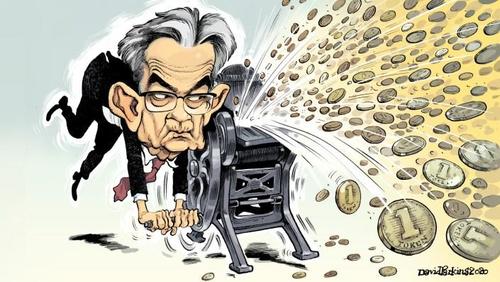
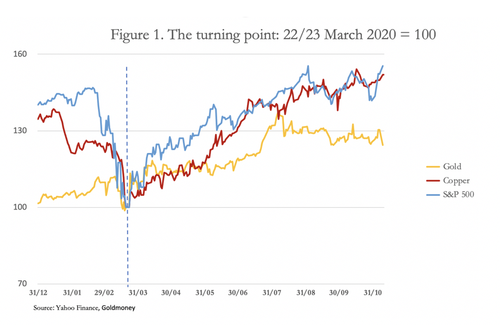
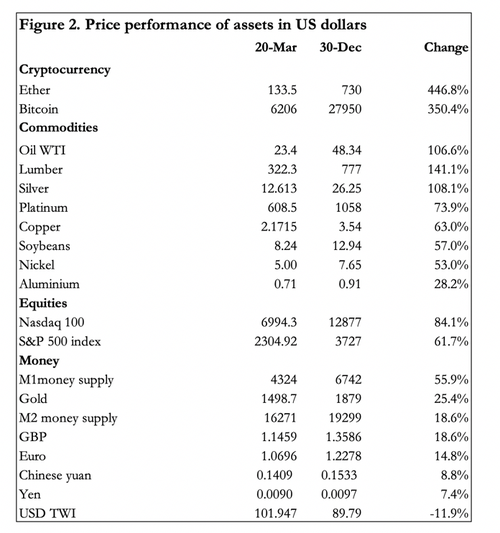
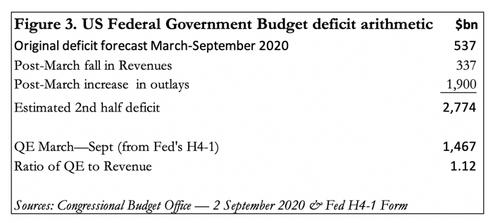
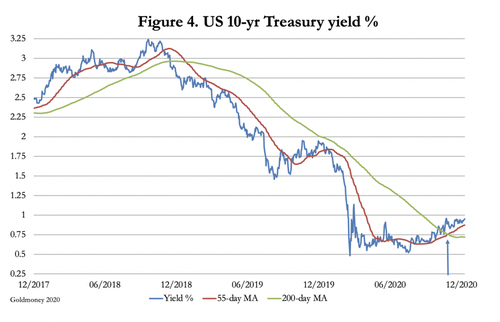


0 comments
Post a Comment